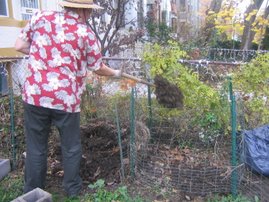 After yesterday's comedy of stuffing too much masa into the mixing bowl, we collected ourselves and set about the task of actually making some tamales.
After yesterday's comedy of stuffing too much masa into the mixing bowl, we collected ourselves and set about the task of actually making some tamales. My wife joined me for a consult as I tried to decide on the best method for spreading the dough on the corn husks and folding the husks into neat little packages.
The first thing my wife commented on was the dough itself. She found it stiff.
"When I've seen ladies making tortillas, they smeared the dough on the husk," she said.
My dough was more like modeling clay. You had to press it with your fingers. I had suspected something was amiss because the recipe I was using, from a cookbook devoted to tamales, had said the dough should be "like a thick pudding." I wondered what kind of pudding the author had in mind.
We began constructing a mis en place for making tamales, meaning we lined up all our ingredients in assembly-line fashion. I wanted to make at least 20 tamales to take to the first of my "food appreciation" classes later in the day. Since the tamales need to steam for an hour on the stove top, I would have to start them cooking on the stove at school before the students arrived for the first class. That way they'd have some tamales to sample before the class ended. I would show them how to make the tamales, but they would eat the ones I prepared earlier. Then the next class would eat the tamales made by the first class. And so forth over the course of two days of classes.
So what you see in these pictures is our system for tamale production. The corn husks, purchased at a local Latino grocery, have been soaking overnight in a basin of water. We spread about 1/4 cup of dough in a rectangular shape in the center of the corn husk, leaving about two inches of husk uncovered at the top and bottom. On the dough we place a small dollop of chicken filling made with crushed tomato, oregano and cumin. Then we place a matchstick slice of potato and one of zucchini, followed by a small spoonfull of salsa verde and three or four golden raisins.
 Since the corn husks vary in size, you learn along the way to vary the amount of dough you spread on the husk. The object is to have just enough dough so that you can overlap the edges of the husk when you fold it closed, then fold the ends over to create a packet. Too much dough and the package will not close. Too little dough and you are just wasting the unused husk.
Since the corn husks vary in size, you learn along the way to vary the amount of dough you spread on the husk. The object is to have just enough dough so that you can overlap the edges of the husk when you fold it closed, then fold the ends over to create a packet. Too much dough and the package will not close. Too little dough and you are just wasting the unused husk.Traditionally the bundle is tied with a strip of corn husk, but I decided that string--or butcher's twine--would be easier to learn with. Even though we are experienced cooks, we're just beginners where tamales are concerned.
 I fumbled at first, but my wife caught on right away. What a surprise! What we really needed was a Mexican grandmother, someone who could show us how it's done. Still, before long, my wife had her own system. She was making three at a time. I was anxious to cook them and see how they tasted.
I fumbled at first, but my wife caught on right away. What a surprise! What we really needed was a Mexican grandmother, someone who could show us how it's done. Still, before long, my wife had her own system. She was making three at a time. I was anxious to cook them and see how they tasted. Tomorrow, a surprise turn, another lesson learned and a happy ending to our tamale saga.










2 comments:
They look great. We'll have to take a stab at authentic tamales when we cook Mexico.
You could hardly go wrong with tamales, Jonathan. They are quintessentially Mexican...
Post a Comment